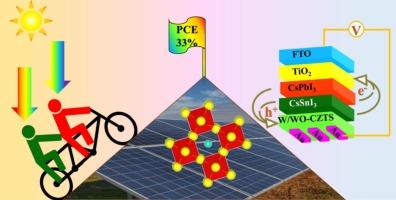Modeling of efficient dual-junction all-inorganic perovskite tandem cells via SCAPS-1D
IF 6
2区 工程技术
Q2 ENERGY & FUELS
引用次数: 0
Abstract
This investigation delivers a detailed SCAPS-1D simulation of all-inorganic, tandem-inspired perovskite solar cells (PSC) utilizing a two-layer absorber configuration. The device configuration FTO/TiO2/CsPbI3/CsSnI3 was evaluated in the presence and absence of a hole transport layer (HTL), using various back contact materials such as gold (Au), silver (Ag), carbon, and CZTS. CsPbI3 (wide bandgap) functions as the top absorber, while CsSnI3 (narrow bandgap) serves as the bottom absorber, allowing strong light harvesting over a wide spectral range. A high-power conversion efficiency (PCE) of 33.75% was attained in the HTL-free configuration. Additionally, replacing conventional metal electrodes with cost-effective, sustainable CZTS maintained excellent device performance. These results demonstrate that efficient energy band alignment and charge transport are achievable without organic HTLs, simplifying the device structure while maintaining high efficiency. This work underscores the potential of all-inorganic, tandem-inspired perovskite architectures for scalable, efficient, and eco-friendly photovoltaic technologies.

基于SCAPS-1D的高效双结全无机钙钛矿串联电池建模
本研究提供了一个详细的SCAPS-1D模拟全无机,串联启发钙钛矿太阳能电池(PSC)利用两层吸收结构。采用金(Au)、银(Ag)、碳和CZTS等各种背触点材料,在有无空穴传输层(HTL)的情况下,对器件结构FTO/TiO2/CsPbI3/CsSnI3进行了评估。CsPbI3(宽带隙)作为顶部吸收剂,而CsSnI3(窄带隙)作为底部吸收剂,允许在宽光谱范围内收集强光。在无html配置中获得了33.75%的高功率转换效率(PCE)。此外,用具有成本效益、可持续发展的CZTS取代传统金属电极保持了优异的器件性能。这些结果表明,在没有有机HTLs的情况下,可以实现高效的能带对准和电荷输运,在保持高效率的同时简化了器件结构。这项工作强调了全无机、串联启发的钙钛矿架构在可扩展、高效和环保光伏技术方面的潜力。
本文章由计算机程序翻译,如有差异,请以英文原文为准。
求助全文
约1分钟内获得全文
求助全文
来源期刊

Solar Energy
工程技术-能源与燃料
CiteScore
13.90
自引率
9.00%
发文量
0
审稿时长
47 days
期刊介绍:
Solar Energy welcomes manuscripts presenting information not previously published in journals on any aspect of solar energy research, development, application, measurement or policy. The term "solar energy" in this context includes the indirect uses such as wind energy and biomass
 求助内容:
求助内容: 应助结果提醒方式:
应助结果提醒方式:


